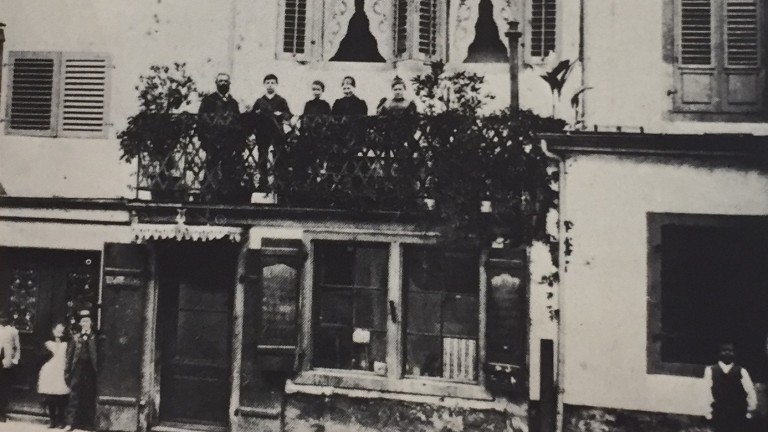Group history
Every future needs a past
2024
150th anniversary
Geberit celebrates its 150th anniversary. Find out more about our company history.
2023
Extension of spare parts availability
Geberit now ensures 50 years of spare parts availability for components of the concealed cistern.
Koło becomes Geberit
The majority of the Polish ceramics brand is marketed under the Geberit name.
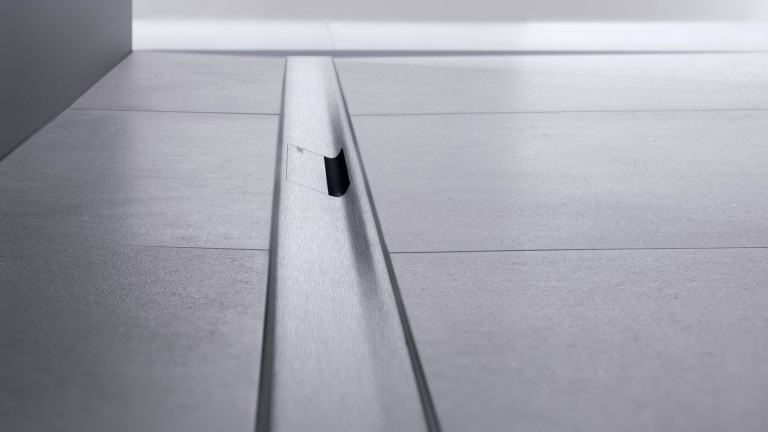
New products 2023
Major product launches are:
- CleanLine50 shower channel
- Sigma70 actuator plate
- Acanto toilet with new TurboFlush flush
- Expansion of the Options mirror range
2022
New CO2 strategy
The new CO2 strategy will be integrated into all relevant business processes in future. As a result, Geberit aims for a CO2 reduction of 5% per year in the medium term, in relation to currency-adjusted net sales.
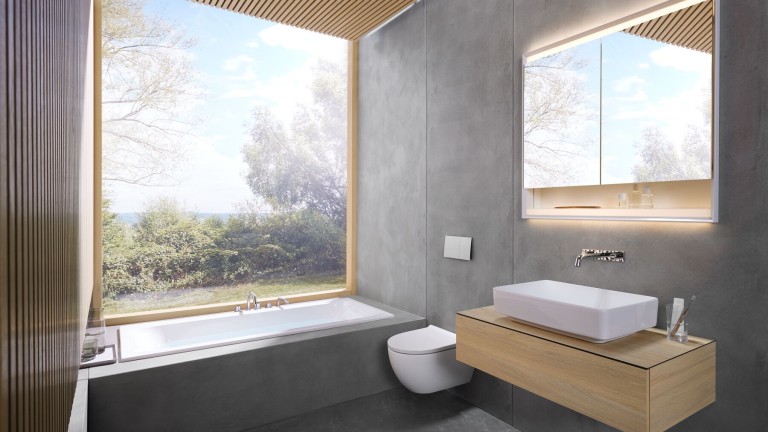
Geberit 6x6 design competition
Architects and designers throughout Europe were invited to design bathrooms with a size of 6 m2 and to equip them with Geberit products. In an online vote, the design by Bjerg Arkitektur from Denmark was chosen as the winner.
Innovations 2022
Major product launches are:
- Flush valve 212
- Offset Fitting Silent-db20
- Infrared remote control type 10
- Concealed cistern Alpha 12 cm
- Extensions of the bathroom series Geberit ONE
2021
Record sales growth
In 2021, the Geberit Group achieved its strongest sales growth since going public in 1999. In the last six quarters, sales grew around three times faster than usual. And, from an operational point of view, under very challenging circumstances due to the coronavirus pandemic.
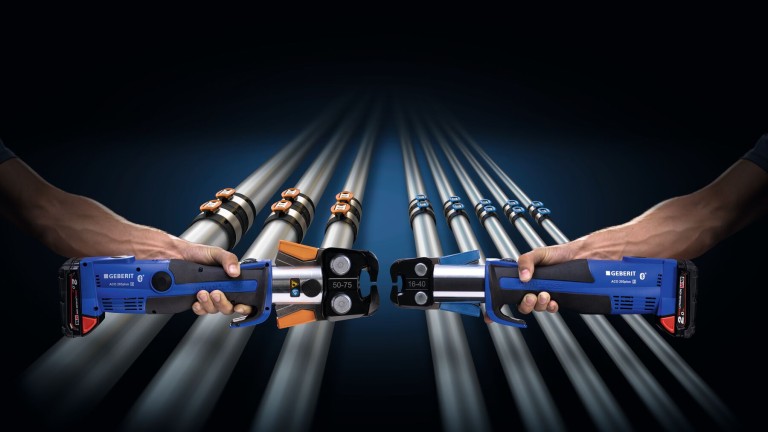
Major product launch
With FlowFit, Geberit introduced a new piping system for drinking water and heating applications. The pressfittings are establishing new standards in terms of easy and reliable installation, but also in terms of their flow characteristics. The development is financially one of the most significant development projects in the history of Geberit.
Geberit Innovation Days
As no trade fairs were possible in the first half of 2021 due to the pandemic, Geberit launched the “Innovation Days”. The company started to present new products and key topics from its new trade fair booth, the “House of Geberit”, streaming them online.
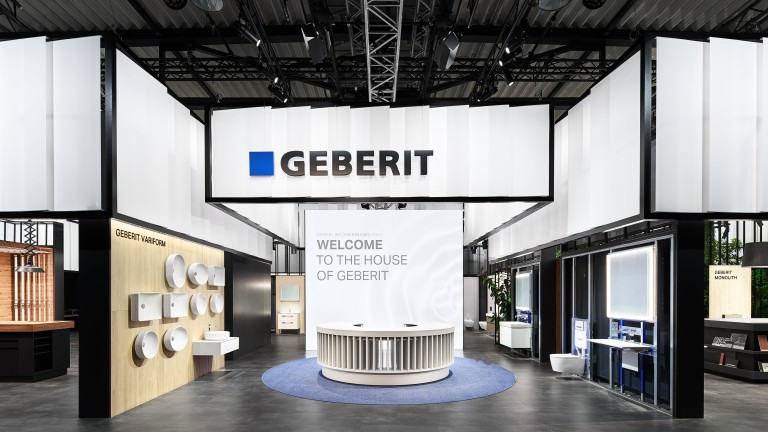
New products 2021
Major product launches are:
- Geberit FlowFit supply system
- Extensions to the Geberit ONE bathroom series
- Sanitary flush for installation in concealed cisterns
- Alpha concealed cistern 12 cm for the Asian region and Africa
- An app for end users for AquaClean shower toilets with an option for remote maintenance
2020
Geberit defies te COVID-19 crisis
Geberit defies the COVID-19 crisis and is able to further consolidate its position as the leading supplier of sanitary products, as demonstrated by the very good annual results.
Second stage of brand consolidation
2020 sees the second stage of the Europe-wide brand consolidation. In France, Italy and the Netherlands, the brands Allia, Pozzi-Ginori and Sphinx are replaced by Geberit (see also 2019).
Premiere in India
Premiere in India with the world’s first installation of the new Geberit SuperTube technology. The efficient drainage system is installed in the “Gateway Towers 1” construction project.

Product launches 2020
Major product launches are:
- CleanLine80 shower channel
- Expansion of the Renova, Selnova and VariForm bathroom series from Geberit
2019
Keramag becomes Geberit
The brand switch primarily affects the largest sales market – Germany – and allows for the focusing of marketing activities, consolidation of product information and simplification of logistics.

Better bathrooms, better lives
With the campaign “Better bathrooms, better lives”, Geberit has set out on the path of communicating directly with the end user. The campaign focuses on their most important requirements – cleanliness, optimisation of space, comfort, user-friendliness, accessibility and design.
Enervit burner technology
Ten kilns in seven ceramics plants are now fitted with Enervit burner technology. As a result, around 27,500 MWh of natural gas and 6,500 tonnes of CO2 can be saved each year.
Product launches 2019
Major product launches are:
- Geberit ONE (bathroom series)
- SuperTube (drainage system for high-rise buildings)
- AquaClean Sela (shower toilet, enhancement)
2018
Prepared for the future
Geberit prepares for the future with record investments in the Operations division, focusing on the ceramics plants in Ekenäs (FI), Slavuta (UA) and Gaeta (IT) as well as on the capacity expansion in Pfullendorf and the modernisation in Langenfeld (both DE).
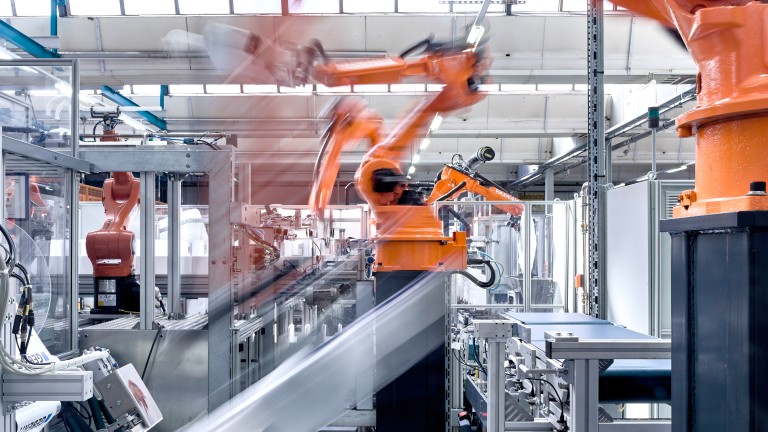
Initial use of CT scanner
In the measuring laboratory in Rapperswil-Jona (CH), a CT scanner is used for the first time. In addition to measuring inner and outer geometries as well as wall thicknesses, this machine also detects irregularities in the plastic.
Product launches 2018
Major product launches are:
- VariForm (washbasins)
- Energy retaining valve
2017
Expanded logistics centre
The expanded logistics centre in the southern German town of Pfullendorf takes over the storage, order picking and shipping of long goods.
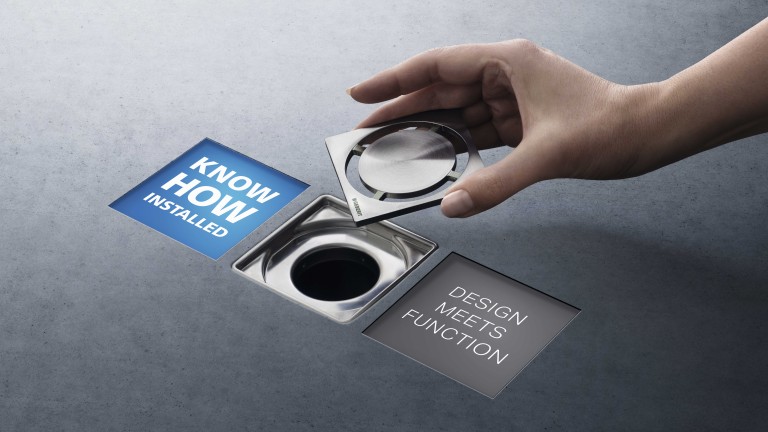
Expertise in front of and behind the wall
“Know-How Installed” has been joined by the claim “Design Meets Function” in order to bring the company’s expertise in front of and behind the wall to the attention of a wider audience.
Product launches 2017
Major product launches are:
- Setaplano (shower surface)
- AquaClean Tuma (shower toilet)
- Acanto (bathroom series)
- Tap system
2016
Sanitec is a single unit
With the start of the new year, the Sales teams of Geberit and the former Sanitec are operating as a single unit. Customers can ask one and the same contact person questions about the entire product portfolio.
AquaClean from Germany
The integration of the Ceramic division is also pushing ahead in production: Since the beginning of the year, the Geberit AquaClean Mera shower toilet is in part being produced in the Wesel plant in Germany.
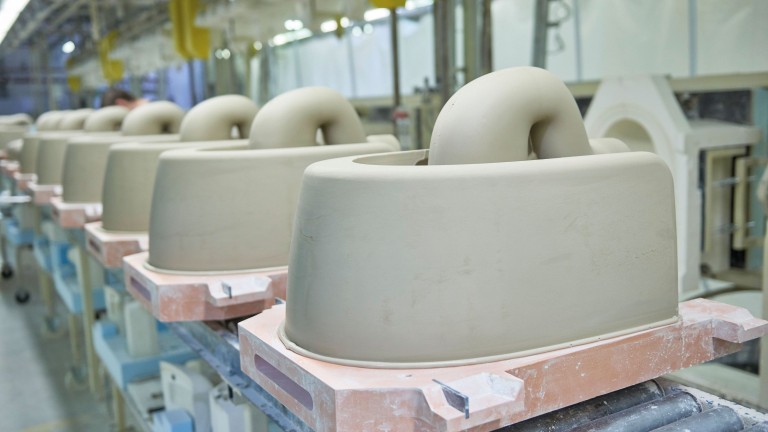
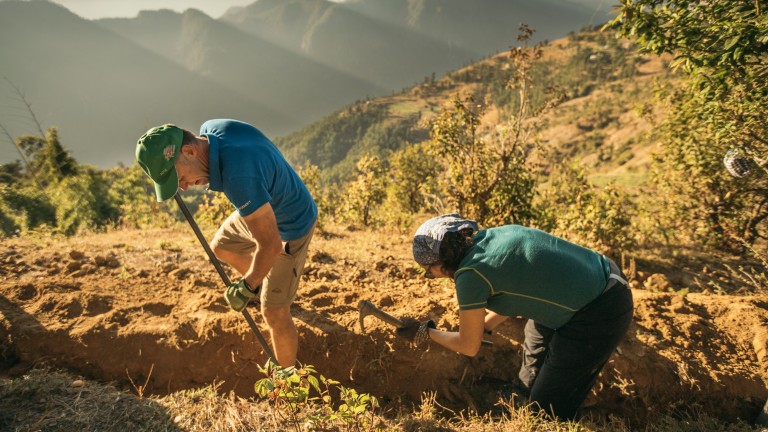
First volunteering project in Nepal
For the first time, a volunteering project is carried out in Nepal in cooperation with the Swiss aid organisation Helvetas.
Product launches 2016
Major product launches are:
- Urinal system
- Silent-Pro (drainage system)
2015
New CEO
Christian Buhl, the successor to Albert M. Baehny, takes up his new role as CEO on 1 January 2015.
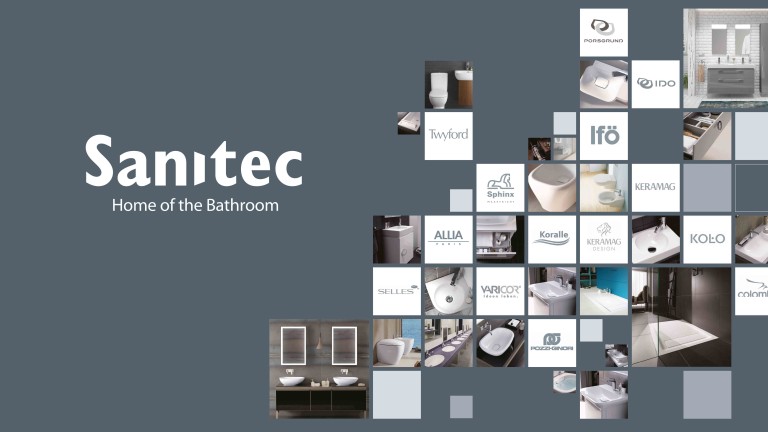
Takeover of Sanitec
Geberit takes over the Finnish Sanitec Group, Europe’s leading provider of ceramic appliances. The total value of the transaction, which was announced in October 2014, amounts to 1.29 billion Swiss francs. The Sanitec Group is home to well-known brands such as Keramag, Ifö, Kolo, Allia and Pozzi-Ginori.
New plant in Slovenia
The opening of the new plant in Ruše (SI) is celebrated.
Product launches 2015
Major product launches are:
- CleanLine (shower channel)
- AquaClean Mera (shower toilet)
2014
50 years of concealed cisterns
Geberit celebrates 50 years of concealed cisterns. As if further proof of its reliability were still required, a set of first generation “UP” cisterns is being replaced in a Swiss alpine hotel – for purely aesthetic reasons.
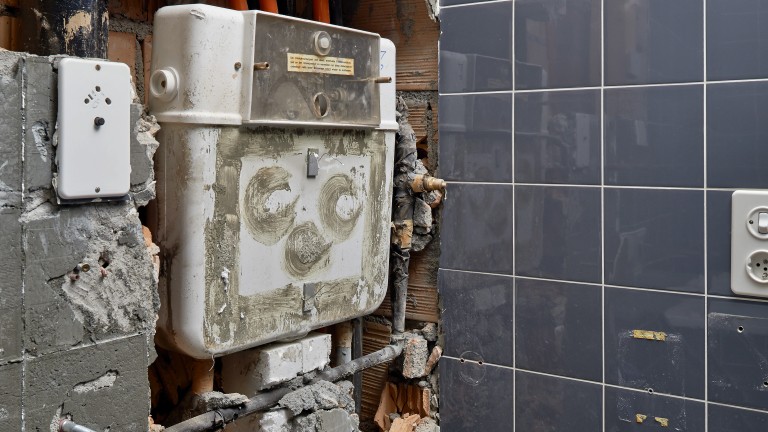
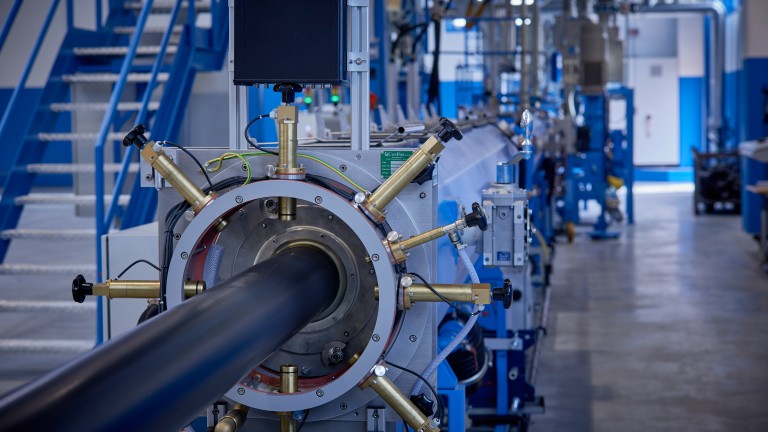
New production hall in Villadose
A 6,600 m2 production hall is completed in Villadose (IT) and a third extrusion line for Silent-PP discharge pipes is commissioned.
Product launches 2014
Major product launches are:
- Omega concealed cistern and flush plates
- Sigma70 (actuator plate)
2013
New plant in India
Production begins at the plant in Pune (IN), where the Alpha concealed cisterns are being manufactured for the Indian market.
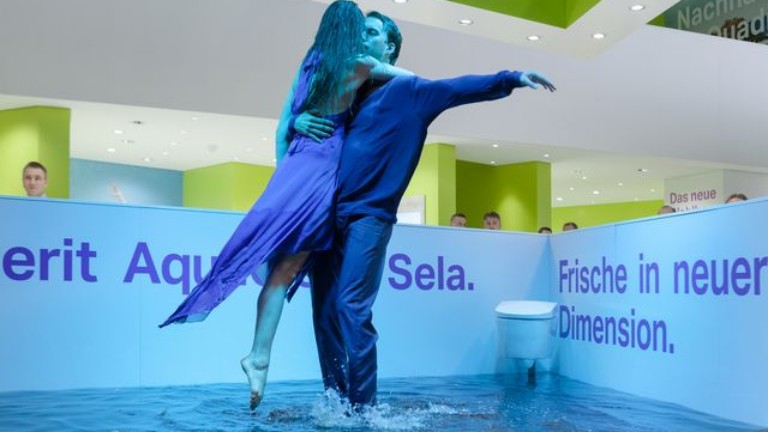
AquaClean Sela is being launched
One of the highlights at the ISH in Frankfurt is the presentation of Geberit AquaClean Sela – the first shower toilet that looks like a normal toilet.
Apprentices in China
For the first time, apprentices are given the opportunity to gain practical experience overseas after completing their apprenticeships – the plant in Shanghai (CN) is the first destination.
Product launch 2013
Major product launch: AquaClean Sela (shower toilet)
2012
Showroom in Denmark
The first Geberit showroom with a “mini acoustics lab” is opened in Copenhagen (DK).
Geberit at Olympia
The Aquatics Centre, which was designed by Zaha Hadid Architects, is one of the most spectacular venues at the Summer Olympic Games in London. This iconic building contains various Geberit products.
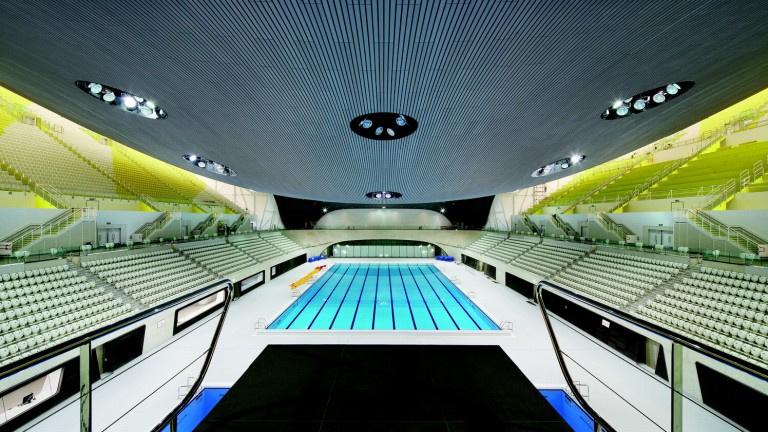
Biomass heating in Pfullendorf
The new block heating station at the Pfullendorf plant (DE) serves as a role model – it is operated using biomass from regional sources.
Product launch 2012
Major product launch: Alpha (concealed cistern, flush plate, specifically for India)
2011
New Chairman of the Board of Directors
Günter F. Kelm steps down as Chairman of the Board of Directors. At the General Meeting, Albert M. Baehny is elected his successor.
Shower toilets made in Jona
The specially set-up Geberit Apparate AG begins producing shower toilets itself at the Rapperswil-Jona site (CH).
Geberit on Tour
The “Geberit On Tour” campaign is launched in several European countries. The technical advisors travel through their countries in stages in order to pass on their know-how on site.
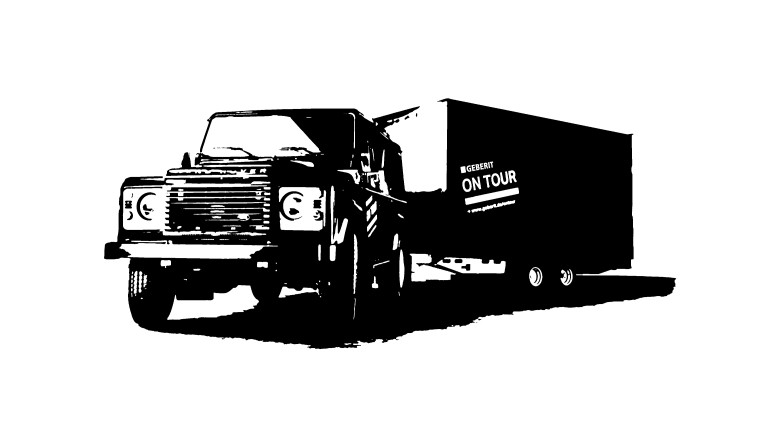
Product launches 2011
Major product launches are:
- DuoFresh (integrated odour extraction unit)
- Wall drain for shower
2010
New Headquarters Asia/Pacific
The official opening of the new Asia/Pacific headquarters in Shanghai (CN) takes place.
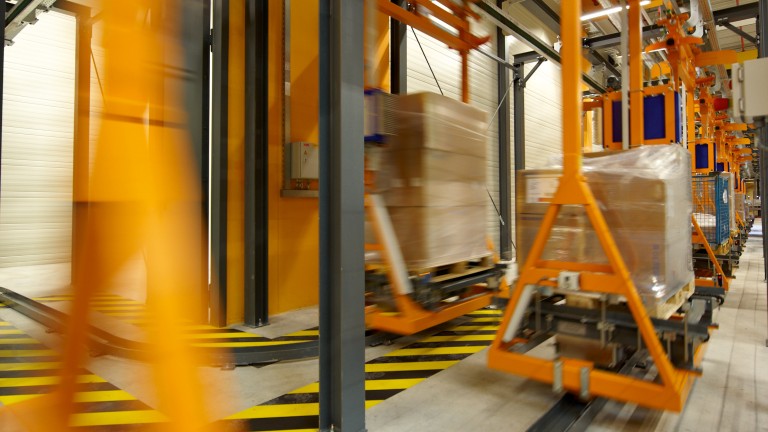
Logistics centre Pfullendorf inaugurated
The logistics centre in Pfullendorf (DE) is inaugurated and immediately begins to systematise processes and consolidate consignments across Europe.
Most sustainable company in Switzerland
During the World Economic Forum’s annual meeting in Davos (CH), Geberit is named Switzerland’s most sustainable company.
Product launches 2010
Major product launches are:
- Monolith sanitary module for WCs
- Shower element with wall drain
2009
New name for shower toilets
The shower toilet is relaunched under the name Geberit AquaClean in Germany, Switzerland and Austria. The core message of the advertising campaign is „I Love Water”.
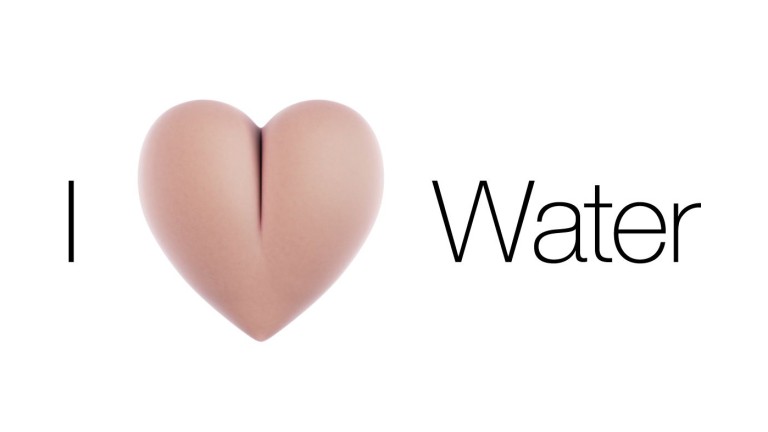
Product launches 2009
Major product launches are:
- PushFit (supply system)
- Silent-PP (sound-insulating drainage system)
2008
Balena is integrated
Geberit Balena – the sales company responsible for the shower toilet – is integrated into the Swiss sales company.
Joining “Global Compact”
Geberit joins the “Global Compact”, a United Nations initiative to promote social commitment by companies.
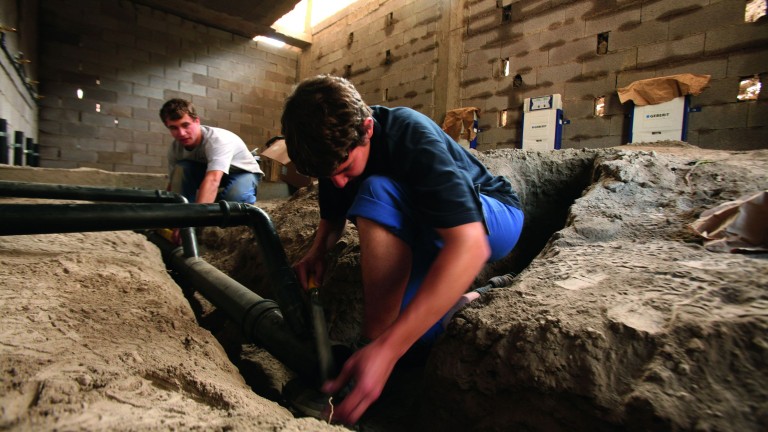
First social project with apprentices
Geberit runs a social project for the first time, with eight apprentices taking part. The project is based at the “Colegio Pomasqui” in Quito (EC).
Product Launches 2008
Major product launches are:
- Sigma10, Sigma20, Sigma50 (actuator plates)
- UP320 (the first concealed cistern that can be installed without tools)
2007
AMS is acquired
AMS, hitherto the exclusive importer of Geberit products in South Africa, is acquired.
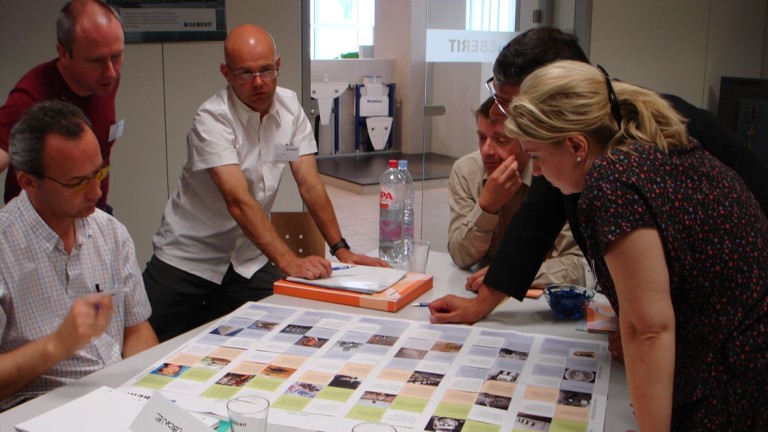
First code of conduct
Geberit introduces respective codes of conduct for employees and suppliers.
2006
Animals advertise Geberit
In a campaign, elephant, eagle and other animals draw attention to the many benefits of Geberit prewall systems: design freedom, stability, concealed technology, versatility.
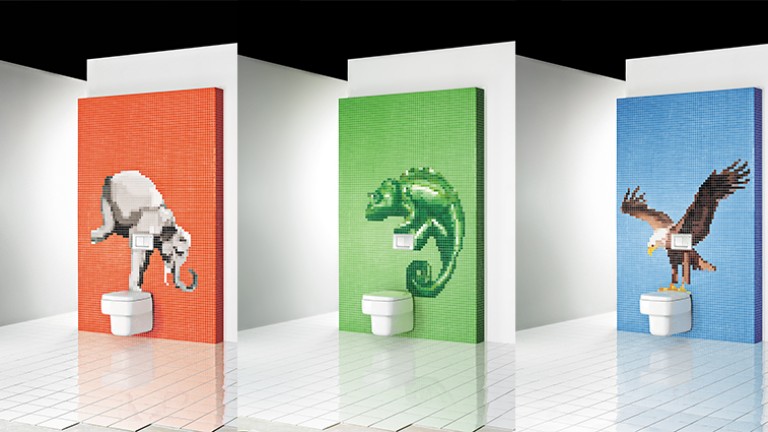
2005
First drinking water tower
The world’s first drinking water tower is inaugurated at the Langenfeld plant (DE). This makes it possible to experience sanitary expertise interactively.
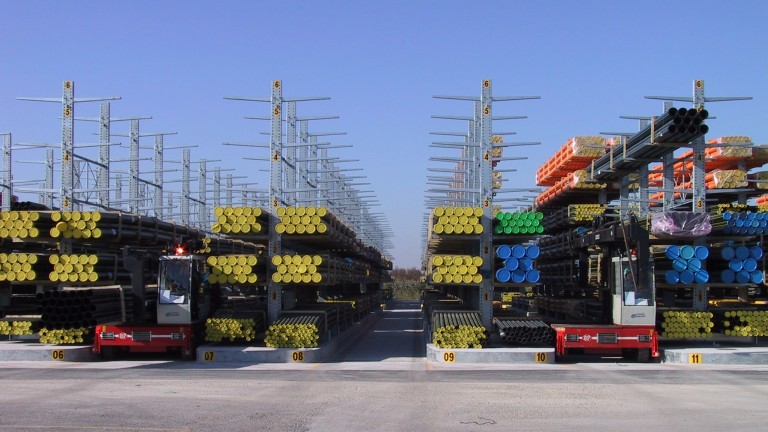
Splitting in Villadose
Geberit splits from Deriplast’s underground piping systems segment. The production of PE and Silent-db20 pipes as well as the manufacture of special piping components remain at the Villadose site (IT).
Geberit International Sales AG founded
Emerging from the former export department, Geberit International Sales AG (GISA) is founded; it serves over 35 markets and initially has branches in Dubai, Moscow and Bucharest.
2004
Geberit acquires Mapress
Geberit acquires Mapress Holding GmbH in Langenfeld (DE), for 372.5 million euros. The Mapress Group is the leading provider in the area of high-quality metal pressfitting piping systems and drainage solutions made of stainless steel, carbon steel and copper.
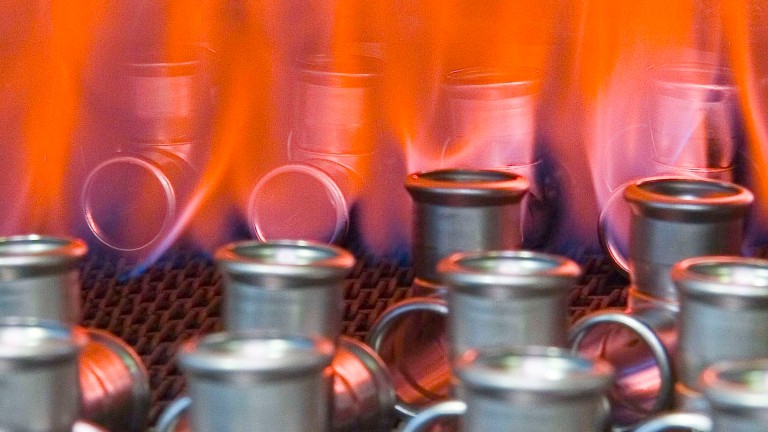
“Know-How Installed”
The marketing slogan (claim) “Know-How Installed” is introduced. From this time on, it can be seen on packaging, amongst other things.
CEO stands down
Günter F. Kelm stands down from his position as CEO as of 31 December and is replaced by his successor Albert M. Baehny.
2003
New building in Manno
The Italian sales company moves into a new administration and customer training building in Manno (CH).
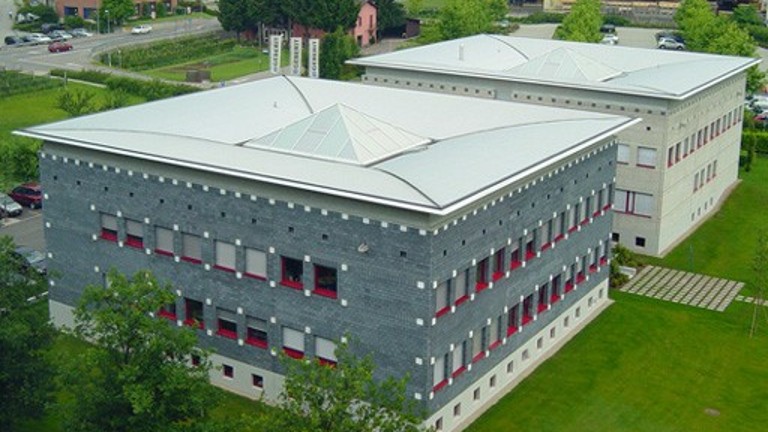
Sales Company in Russia
Geberit opens an official sales company in Moscow (RU).
2002
Expansion in the USA
Geberit expands its operations in the USA and acquires all shares in the Chicago Faucet Company headquartered in Des Plaines, Illinois; shortly afterwards, it also acquires WC Technology Corporation in Farmington Hills, Michigan.
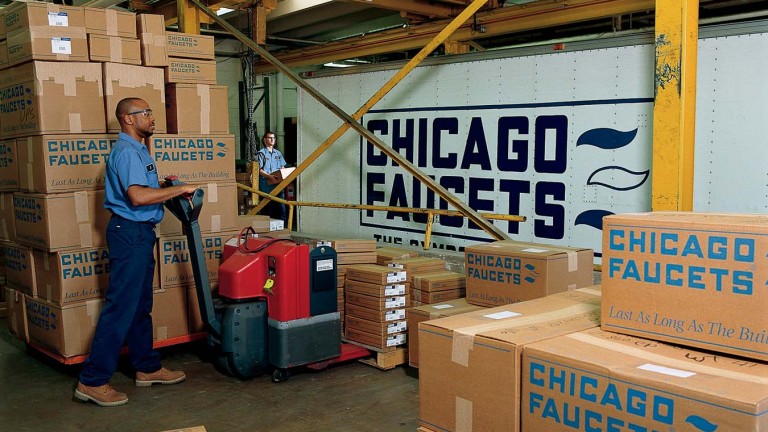
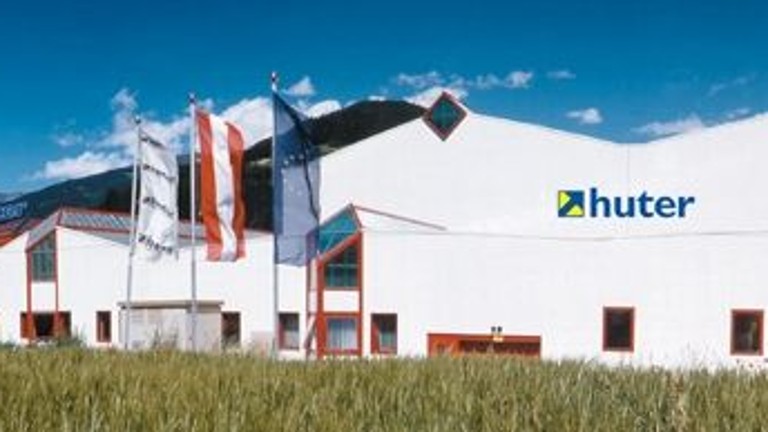
Acquisition of Huter interests
Geberit acquires an interest in Huter Vorfertigung GmbH, a company based in Matrei am Brenner (AT). It will acquire the remaining shares in 2004.
New sales company in Autralia
A new sales company is opened in Australia with its headquarters based in Sydney.
2000
New Information Centre in Jona
The new Geberit Information Centre is opened in Jona (CH).
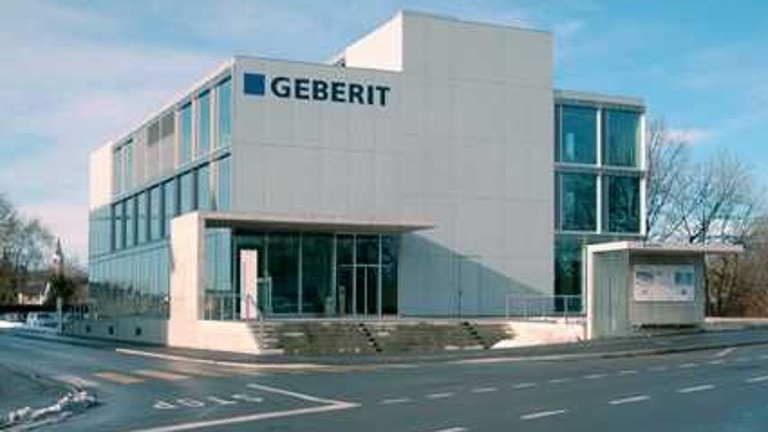
1999
Going public at Swiss Stock Exchange
Geberit successfully goes public on the Swiss Stock Exchange. At the same time, it introduces an attractive employee participation plan.
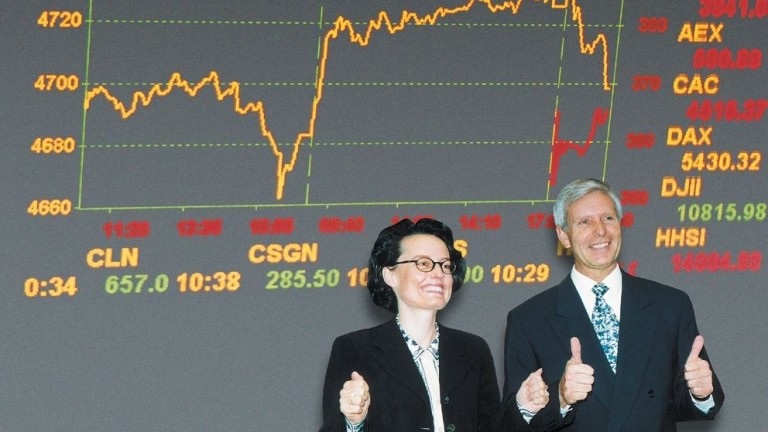
New logistics centre
A new logistics centre commences operations in Pfullendorf (DE).
1998
Sales surpass one billion Swiss francs
For the first time, Geberit Group sales surpass one billion Swiss francs. The company begins preparations for a listing on the stock exchange.
1997
Family shareholders sell company
The family shareholders sell the company to the British investment company Doughty Hanson & Co. The Group Executive Board, together with other executive managers, acquires an interest in the company and thus preserves the operational independence of the Geberit Group.
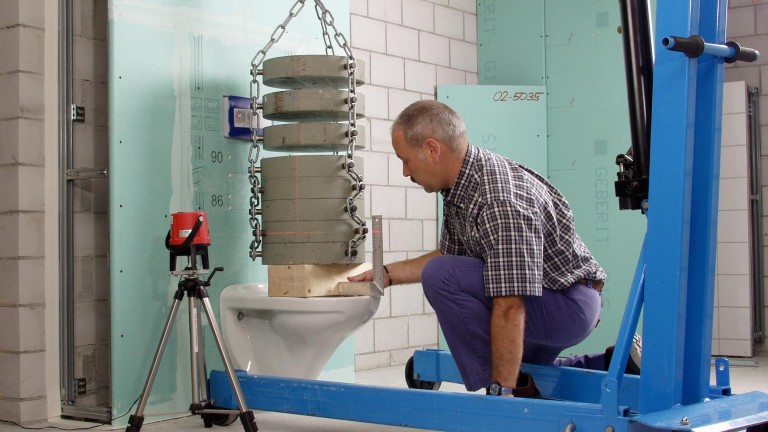
New laboratory in Jona
The building technology and acoustics laboratory in Jona (CH) is completed.
Prosan is acquired
Prosan, a company based in Ruše (SI), is acquired. It produces concealed cisterns and interior fittings for ceramic cisterns.
1995
Deriplast is fully taken over
Deriplast S.p.A., a plastic pipe manufacturer from Villadose (IT), is fully taken over; Geberit had held a minority interest of 26% since 1989.
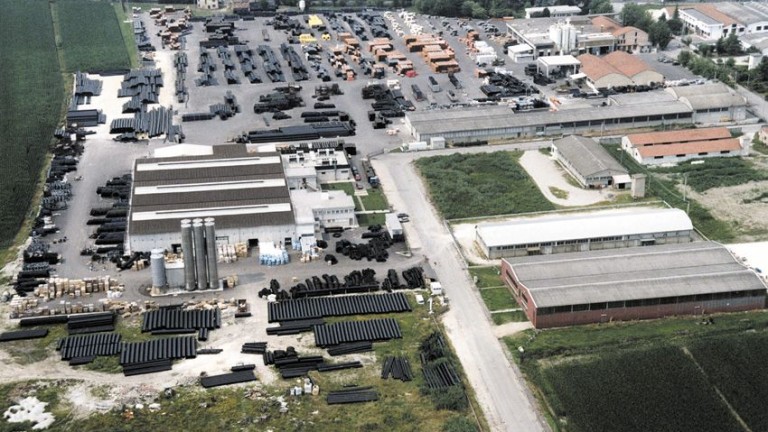
1992
Geberit Lichtenstein founded
Geberit Lichtenstein GmbH is founded in St. Egidien, Saxony (DE); from this point onwards it produces installation elements and frames.
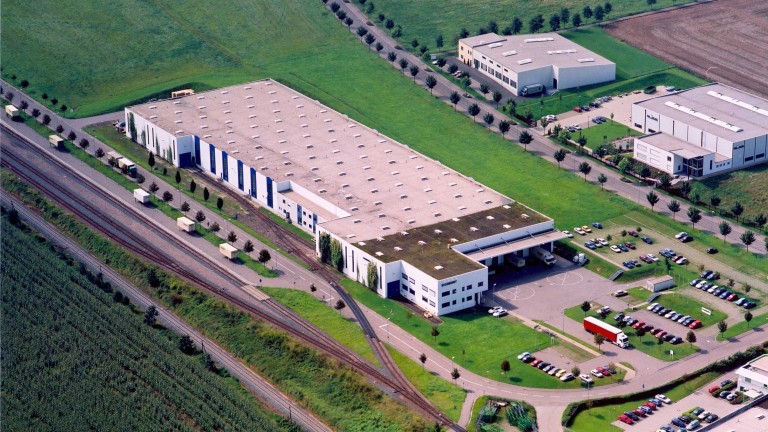
1991
Founding family retires
The members of the founding family retire from operational management. In the following years, the new CEO, Günter F. Kelm, leads the restructuring of the Geberit Group, with the sales, production and services activities being grouped into separate divisions while all research and development activities are centralised at the Jona site (CH).
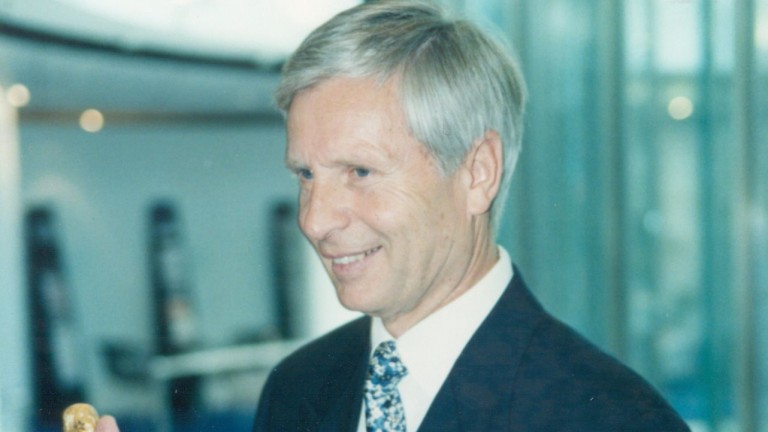
1990
New plant in Pottenbrunn
A new plant is constructed in Pottenbrunn (AT).
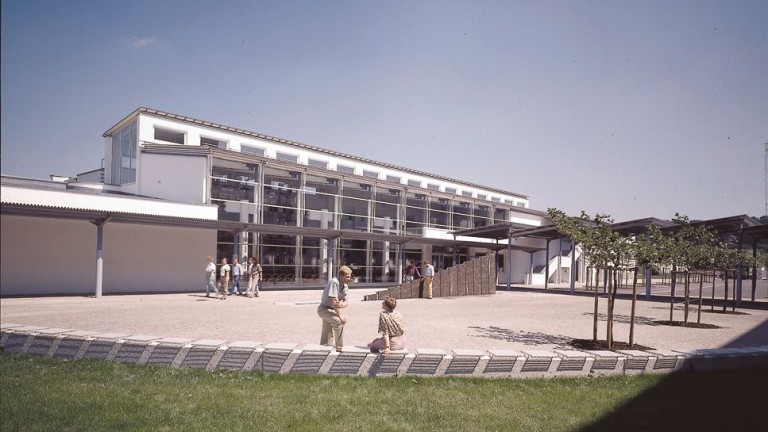
Information Centre in Pfullendorf
A new Geberit Information Centre is constructed in Pfullendorf (DE).
First environmental strategy
The first comprehensive environmental strategy is developed.
1985
Acquisition of Sanbloc
Acquisition of Sanbloc GmbH in Weilheim (DE). This company manufactures prefabrication components.
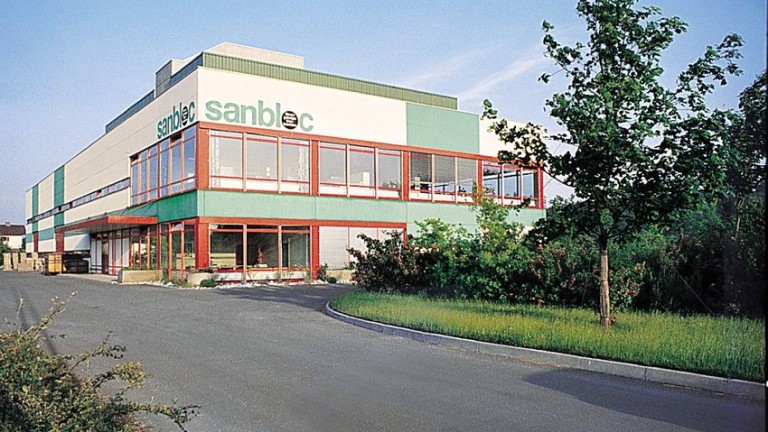
1984
Information Centre in Manno
A Geberit Information Centre specifically for the Italian market is opened in Manno (CH).
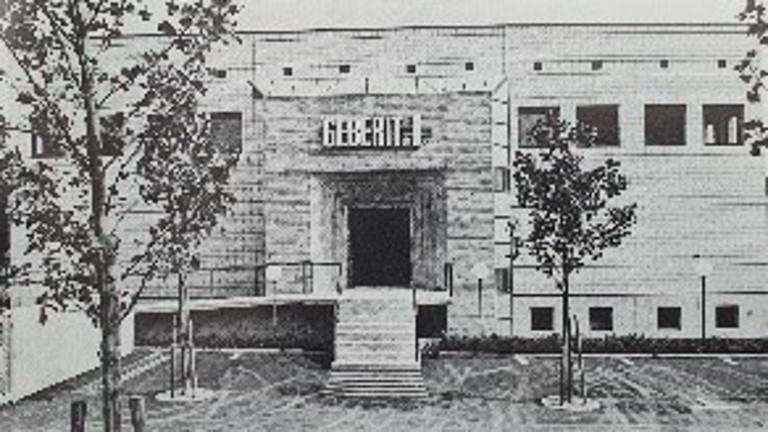
New sales company in Denmark
The local sales company for Denmark is founded, with its headquarters in Lystrup.
1978
Geberella Shower Toilet launched
The Geberella shower toilet is launched; the WC enhancement solution is sold until 1993.
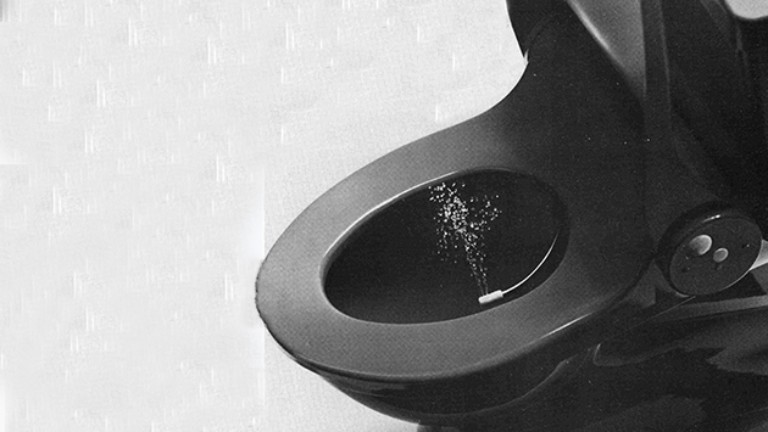
1977
First installation systems
With the introduction of installation systems, the range of products is expanded.
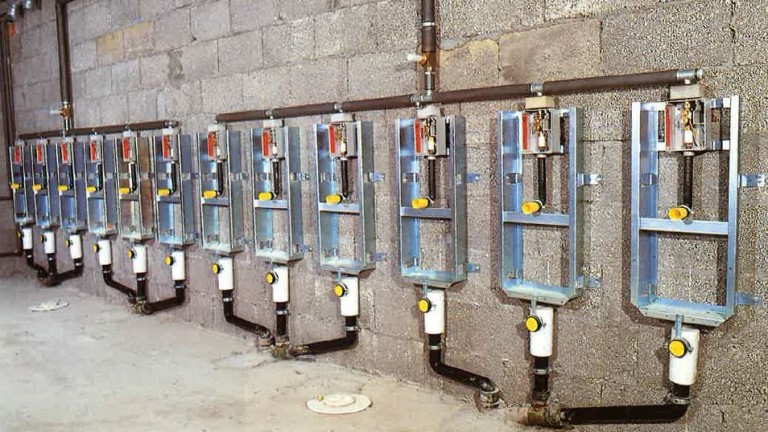
1976
Geberit becomes Holding
Geberit’s corporate structure is reorganised and Geberit Holding SA established.
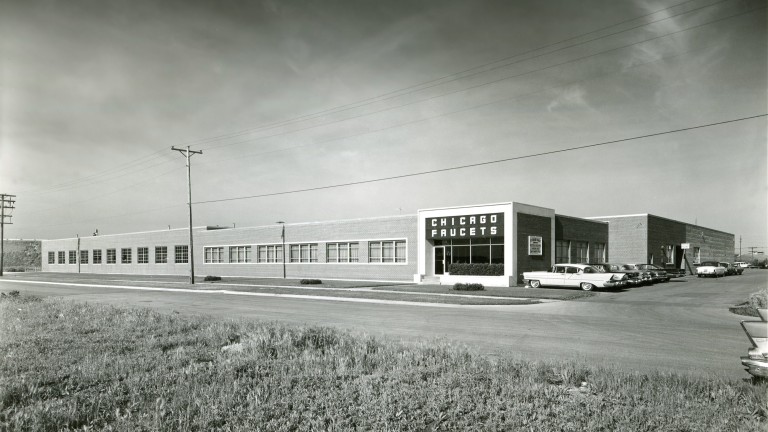
Expansion into the USA
Geberit expands into the USA and establishes the subsidiary Geberit Manufacturing Inc. with its headquarters in Michigan City, Indiana.
1973
New sales company in Amsterdam
The local sales company for the Netherlands is founded, with its headquarters in Amsterdam.
20 years Heinrich and Klaus Gebert
For a period of 20 years, the brothers Heinrich and Klaus Geberit have been at the helm of the enterprise that has become an international corporation by now.
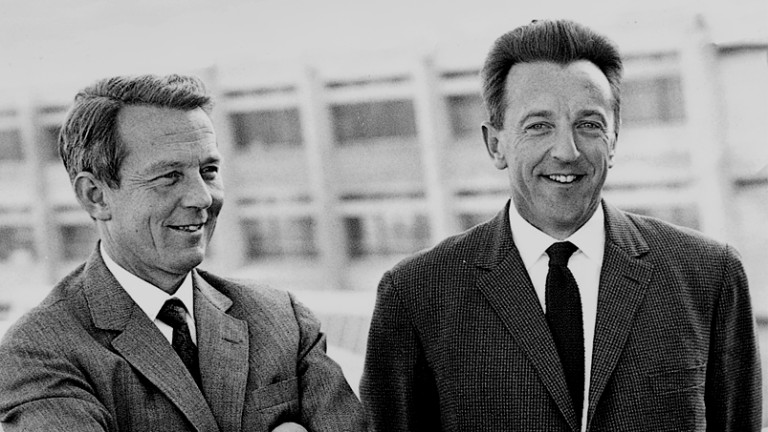
1972
New technology for cisterns
Blow moulding technology is introduced; this enables the rationalised production of cisterns.
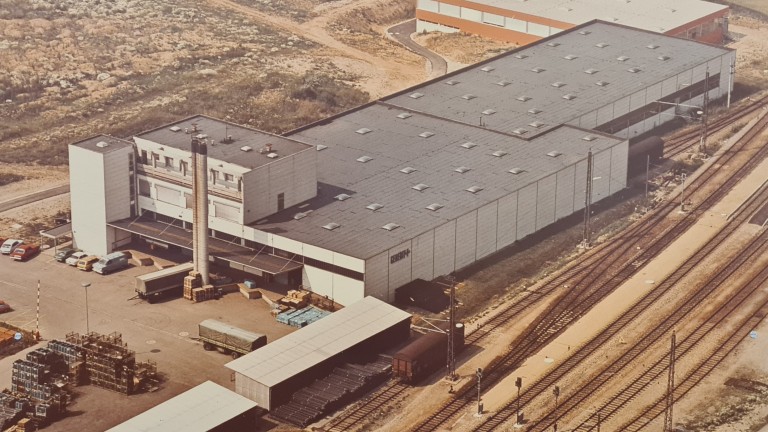
New Plant in Pottenbrunn
Geberit opens a new plant in Pottenbrunn (AT), 50 kilometres west of Vienna.
Sales company in Belgium
The local sales company for Belgium is founded, with its headquarters in Brussels.
1967
New plant in Pfullendorf
A completely new factory is opened in Pfullendorf (DE).
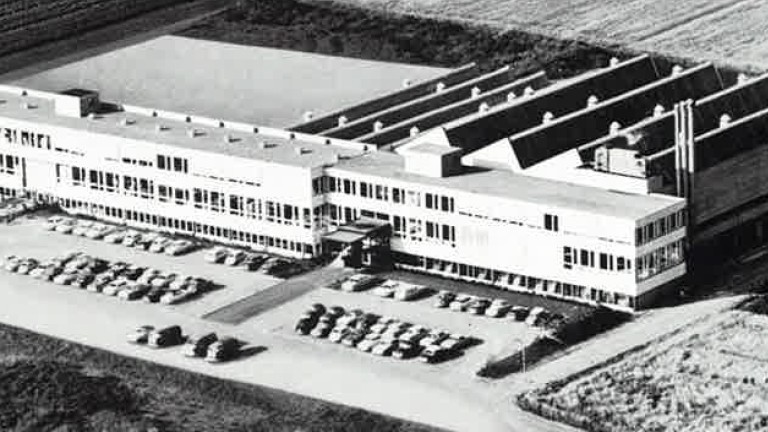
1964
First concealed cistern
Introduction of the first concealed cistern.
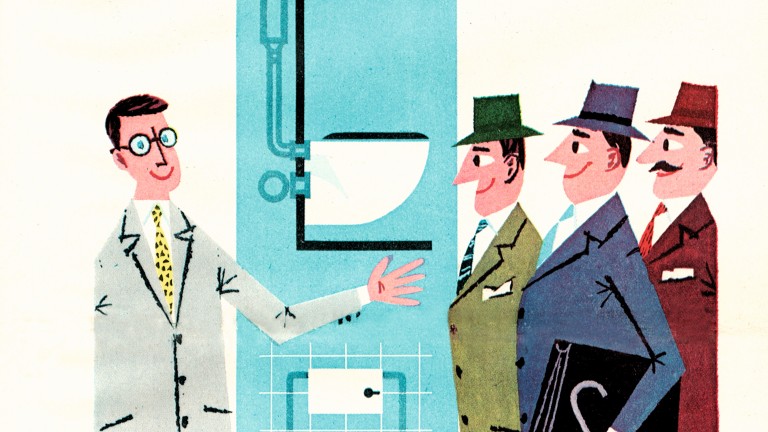
1962
Expansion in Jona
Geberit expands further and moves into new premises in the industrial park in Jona (CH), Rapperswil’s neighbouring municipality.
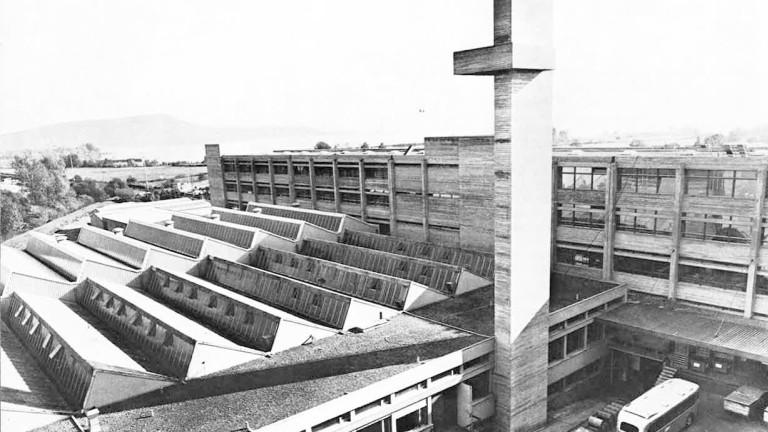
1959
Sales company in Paris
The local sales company for France is founded, with its headquarters in Paris.
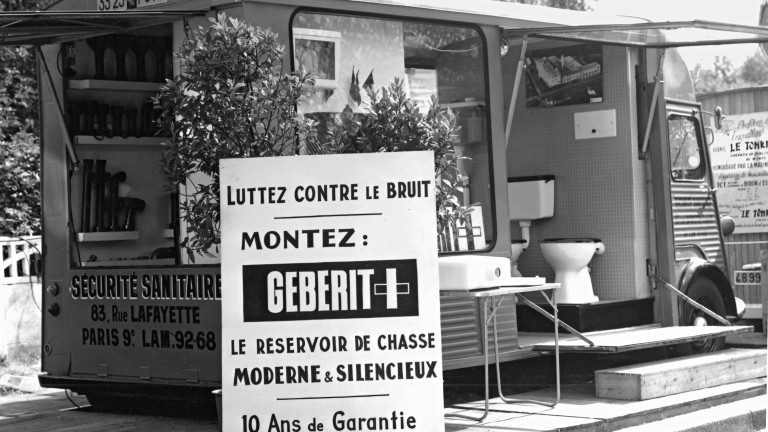
1957
Venture into drainage technology
As a logical consequence of the market success experienced by the plastic cisterns, Geberit takes up production in the area of drainage technology. In this field, the company also predominantly uses plastic, producing traps and other moulded components from polyethylene (PE).
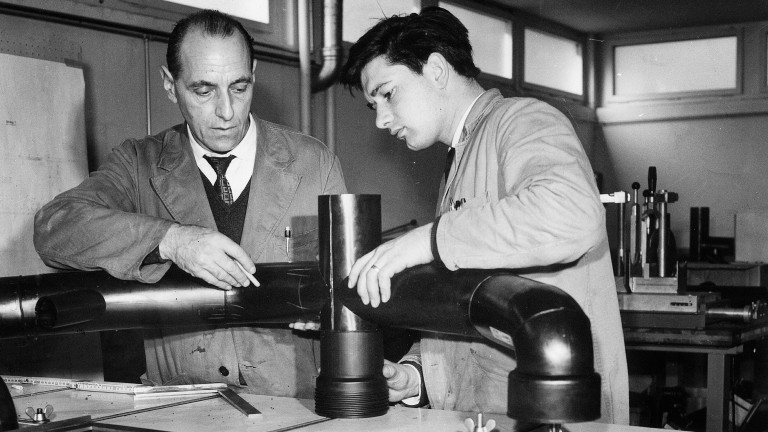
1955
Sales company in Pfullendorf
The German sales company is founded in Pfullendorf. It has its own production facilities.
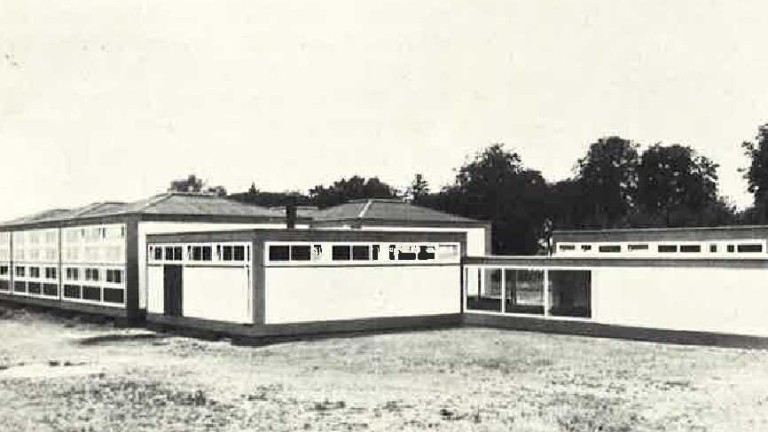
1953
Geberit is being registered
The name “Geberit” is registered as a trademark and is used as the brand name and quality label for all Geberit products from this point on.
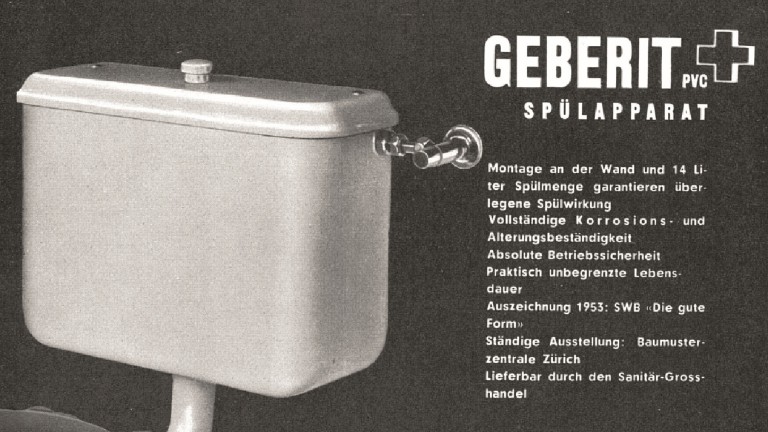
Third generation takes over
With Heinrich (1917-2007) and Klaus Gebert (1926-1998), the third generation of the founding family takes over management of the ailing company.
1952
First plastic cistern
The first plastic cistern is produced, with the company experiencing a marked upswing in the wake of this product breakthrough.
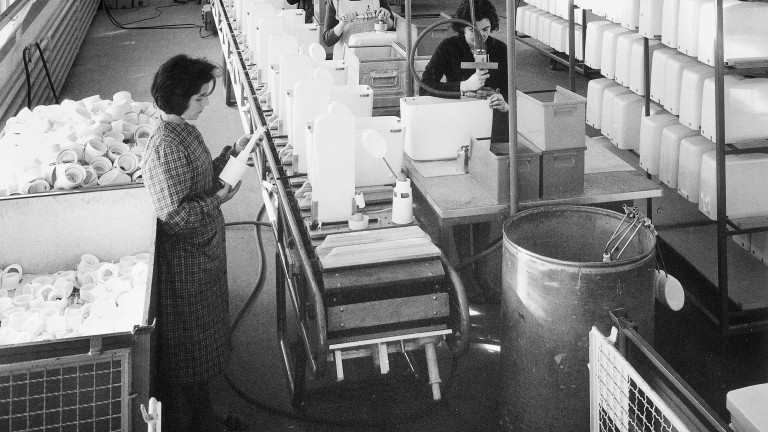
1939
Flat roofs instead of cisterns
During the Second World War, the company keeps afloat by building flat roofs made of pumice slabs, with the Swiss Federal Institute of Technology in Zurich among its clients (picture: Swiss National Exhibition in 1939, Zurich).
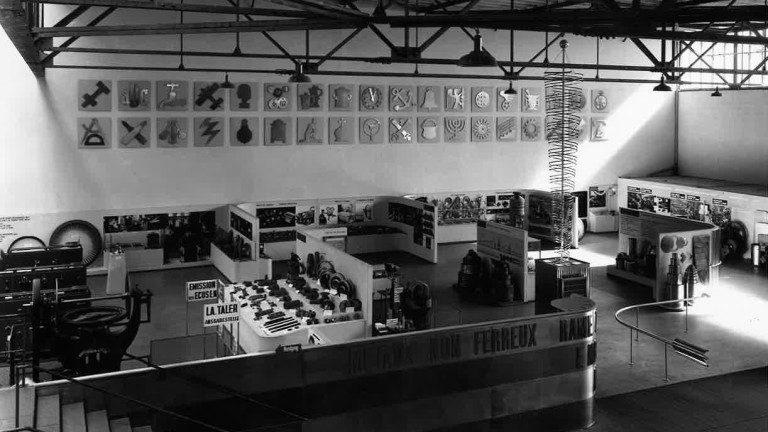
1935
Venture into plastic processing
The company ventures into the new field of plastics processing, at this time a very new technique – a groundbreaking development.
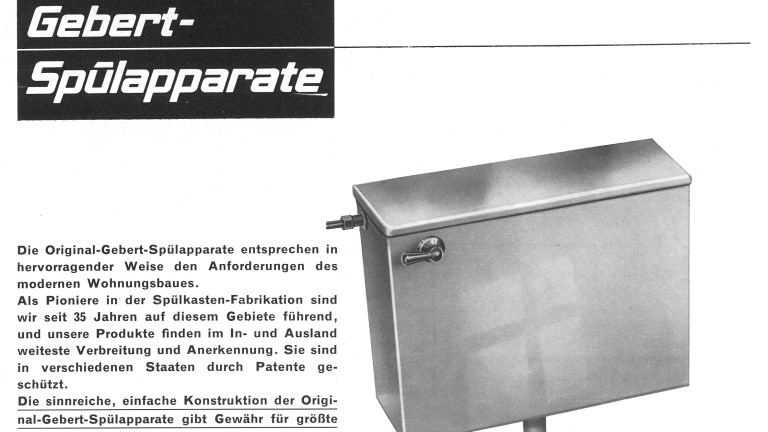
1929
First foreign office
Albert Emil Gebert opens the company’s first foreign office with retail depot in Paris.
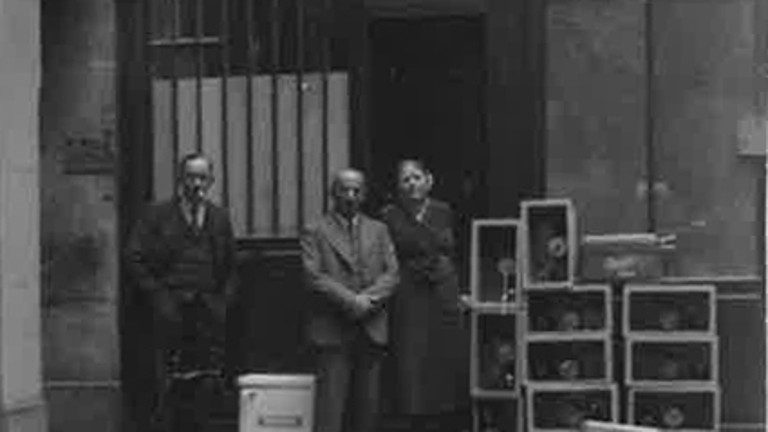
1921
New manufacturing building
In the new manufacturing building on Falkenstrasse, production is concentrated on lead-lined cisterns with brass and lead mechanisms and ballcocks; traps and stop valves made of lead for the acids industry are soon added to the range of products.
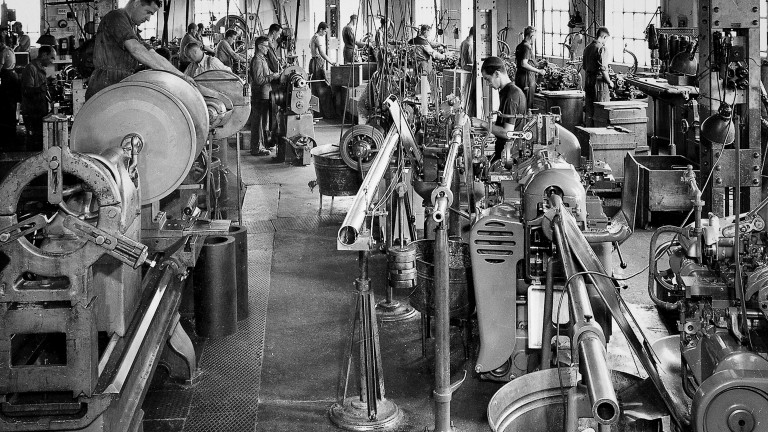
1916
Purchase of plot in Rapperswil
A milestone is reached in the history of Geberit with the purchase of a plot in the Falkenstrasse in Rapperswil (CH). Albert Emil Gebert buys a 1,493 m2 piece of land for the price of 8.50 Swiss francs per square metre; construction of the new production plant begins the next year.
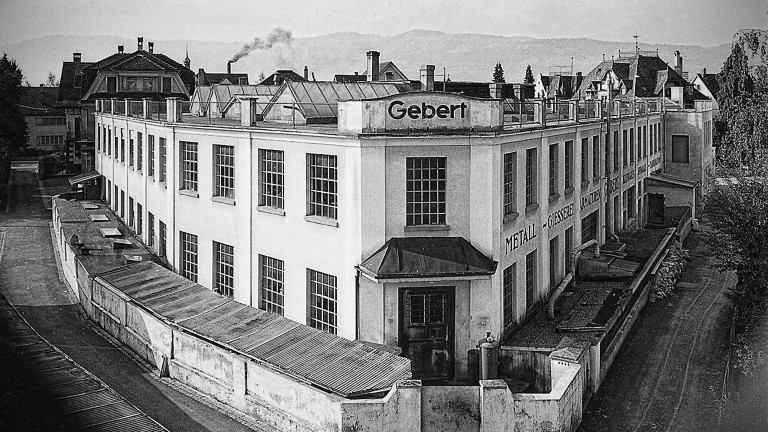
1912
First patent for “Phönix”
The first patent for the “Phönix” wooden cistern is registered. The company is soon supplying customers throughout Switzerland and neighbouring countries with this reliable cistern.
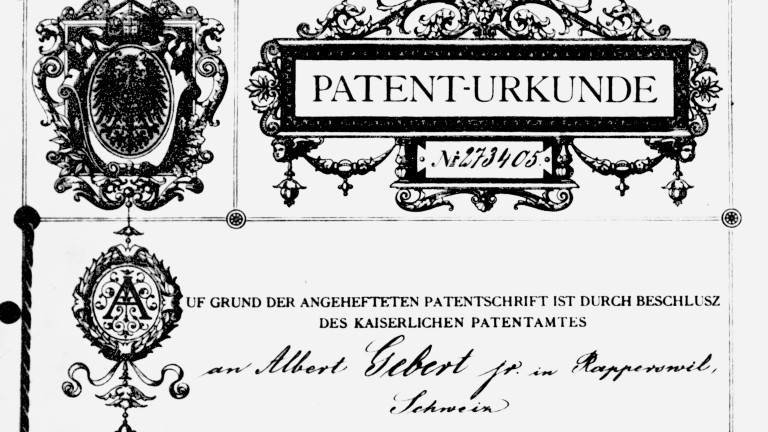
1909
First swiss cisterns
The first cisterns produced in Switzerland leave the production plant in Rapperswil.
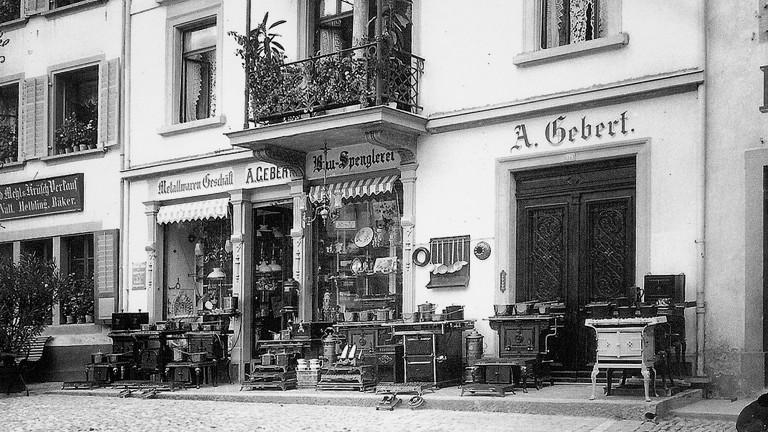
Sons take over
After the death of their father, the sons Albert Emil Gebert (1880-1969) and Leo Gebert (1888-1964) take over the business.
1905
First lead-lined wooden cistern
The sons Albert Emil and Leo Gebert succeed in manufacturing the first, lead-lined wooden cistern with lead fittings; called “Phönix”, this product is the cornerstone for future growth.
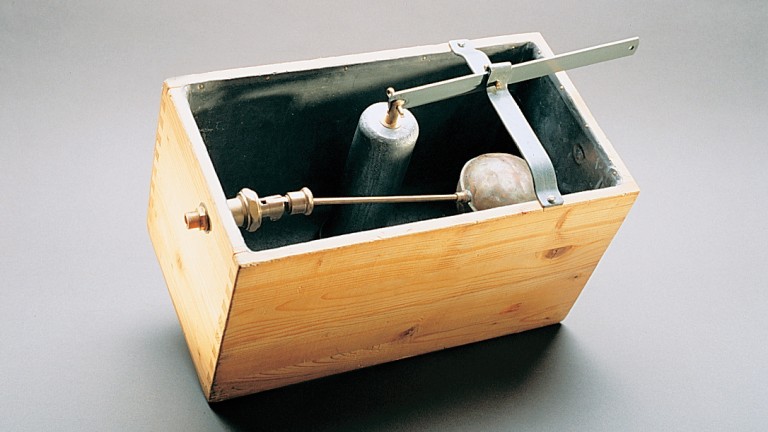
1897
Purchase of “Phönix” property
The ”Phönix” property on the sunny side of the Engelplatz is purchased. One year later, the workshop is moved to these premises and a store is opened on the ground floor.
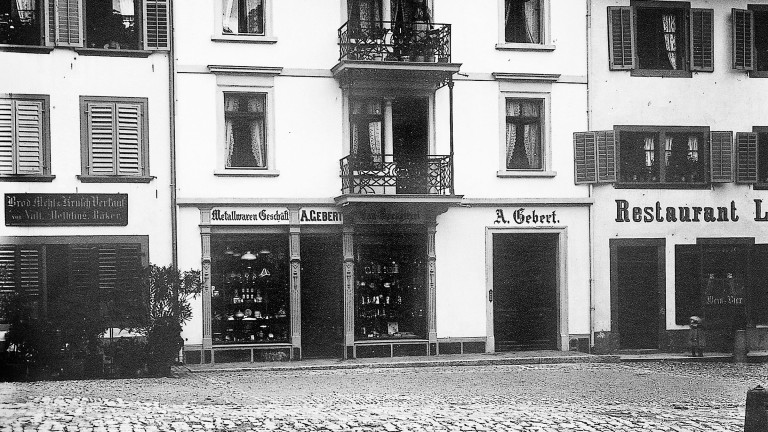
1876
Founder marries and buys property
The company founder marries Josefina Domeisen, three years his junior. He purchases the corner property at Herrenberg 25/Halsgasse 39 from her family. The marriage produces the sons Albert Emil and Leo Gebert.
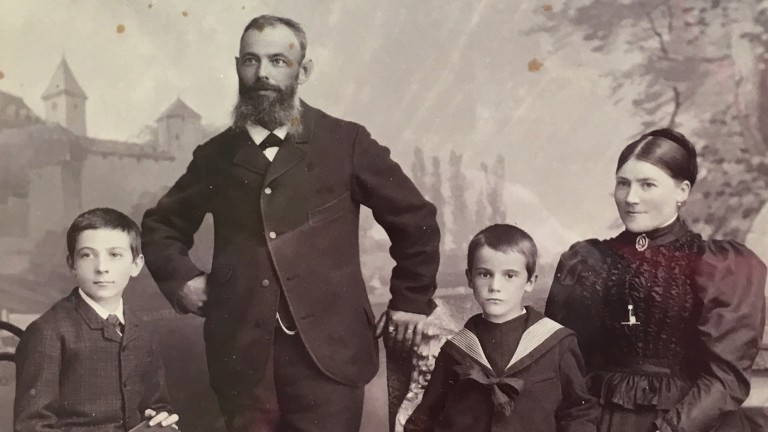
1874
Caspar Gebert opens tinsmith business
Caspar Melchior Albert Gebert (1850-1909) of St. Gallenkappel, Switzerland, opens tinsmith business on the Engelplatz in the old town quarter of Rapperswil (CH).
